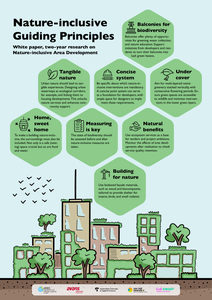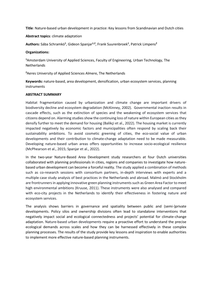The city is nature. In many ways this bold statement can be contested, but at the same time wildlife is so abundant Rotterdam is called a wilderness park (Reumer, Wildpark Rotterdam. De stad als natuurgebied. Historische Uitgeverij, Groningen, 2014). One can discuss whether this is true or not, but more interesting is to see the city as a piece of nature, and as such undertake the actions to develop it further. In a city nature should not be treated as something worth to preserve, after all such unique nature can hardly be found inside urban contexts, rather something to increase, enrich and make more resilient
LINK
Urban nature enhancement is a theme that needs to be considered across different scales. From pocket parks and façade-greening to urban green infrastructure, biodiversity thrives best through connectivity.In the SIA-project, Nature-inclusive Area Development, four universities of applied sciences - Aeres University of Applied Sciences, Avans University of Applied Sciences, Amsterdam University of Applied Sciences, and Van Hall Larenstein University of AppliedSciences- researched three levels of area development to accelerate the transition to nature-inclusive area development. The study consisted of three case studies: Waarder Railway Zone (building), Knowledge Mile Park (KMP - street - Amsterdam), and AlmereCentre-Pampus (area).
DOCUMENT

In recent years, numerous environmental psychology studies have demonstrated that contact with nature as opposed to urban settings can improve an individual’s mood, can lead to increased levels of vitality, and can offer an opportunity to recover from stress. According to Attention Restoration Theory (ART) the restorative potential of natural environments is situated in the fact that nature can replenish depleted attentional resources. This replenishment takes place, in part, because nature is deemed to be a source of fascination, with fascination being described as having an ‘‘attentional’’, an‘‘affective’’ and an ‘‘effort’’ dimension. However, the claim that fascination with nature involves these three dimensions is to a large extent based on intuition or derived from introspection-based measurement methods, such as self-reports. In three studies, we aimed to more objectively assess whether these three dimensions indeed applied to experiences related to natural environments, before any (attentional) depletion has taken place. The instruments that were used were: (a) the affect misattribution procedure (Study 1), (b) the dot probe paradigm (Study 2) and (c) a cognitively effortful task (Study 3).These instrument were respectively aimed at verifying the affective, attentional and effort dimension of fascination. Overall, the results provide objective evidence for the claims made within the ART framework, that natural as opposed to urban settings are affectively positive (cfr., affective dimension) and that people have an attentional bias to natural (rather than urban) environments (cfr., attentional dimension). The results regarding the effort dimension are less straightforward, and suggest that this dimension only becomes important in sufficiently difficult cognitive tasks.
DOCUMENT

Loneliness and social isolation are increasingly recognized as important challenges of our times. Inspired by research hinting at beneficial effects of interacting with nature on social connectedness and opportunities provided by ambient technology to simulate nature in a rich and engaging manner, this study explored to what extent digital nature projections can stimulate social aspirations and related emotions. To this end, participants (N = 96) were asked to watch, individually or in pairs, digital nature projections consisting of animated scenes which were either dense or spacious and depicting either wild or tended nature. Subsequently, they filled out a questionnaire comprising measures for social aspirations, awe and fascination. Results show that spacious scenes elicited significantly higher social aspiration and awe scores, especially when watching alone. Design implications are discussed for making digital nature accessible for people with limited access to real nature.
DOCUMENT

OBJECTIVE: Loneliness and social isolation are pressing issues that can seriously impact the mental health and well-being of older adults. Interacting with nature can stimulate a feeling of connectedness. However, for older adults, access to nature is often troublesome because of physical limitations and mobility restrictions.METHODS: In the present mixed-method study, 37 older adults (62-99 years old) with varying care needs and mobility restrictions watched a video presenting a walkthrough of a simulated digital nature landscape.RESULTS: Quantitative results show a significant increase in social connectedness scores and enhanced peacefulness after experiencing a digital nature. Qualitative results stress the importance of variations in nature scenery and highlight the influence of contextual and person-related factors including nature experiences throughout the life span and mobility constraints that older adults may face.CONCLUSION: These findings testify to the potential of using digital nature as a complementary strategy when interactions with outdoor nature become increasingly difficult due to old age.
DOCUMENT

This chapter is about the development of tourism in the Dutch Wadden Sea Region in combination with nature conservation. The main question is whether they have a common future. There are some future points stated:- Nature and landscape of the Wadden Sea are the main pull factors for the tourism development. - Future tourism development requires a clear strategy that is supported by various stakeholders- Raising awareness about the natural values results in more visitors and public support for nature conservation- The World Heritage status facilitates cooperation between local entrepreneurs and nature conservation organisationsOverall the conclusion can be drawn that, stimulated by the World Heritage status of the Wadden Sea and facilitated by a trilateral Sustainable Tourism Strategy, tourism development and nature conservation and can mutually benefit. Raising awareness about the natural values of the Wadden Sea will result in more visitors to the region and contributes to an emotional attachment to the protected area and public support for the conservation programs.
DOCUMENT

Feelings of disconnectedness and social isolation among older adults are increasingly recognised as important challenges of our times. Interestingly, nature interaction can stimulate social connectedness and enhance perceived social support, indicating that nature can contribute to social wellbeing. However, nature may not always be around or accessible for older adults. In such cases, digital nature could provide an alternative means for enjoying nature's benefits. To identify limitations and restrictions that older adults experience with respect to nature interaction, and to explore preferences with respect to digital nature and their potential for influencing social wellbeing, two studies are reported: a qualitative study comprising focus groups with Dutch care centre residents (N = 26) and a subsequent quantitative study (N = 200) testing effects of digital landscapes on social wellbeing measures. Findings from the focus groups indicate that opportunities for nature interaction and preferences for digital nature vary with mobility restrictions, whereas findings from the quantitative study testify to the potential of digital nature for enhancing social wellbeing and related emotions. These findings extend research on how (digital) nature interventions can contribute to the social wellbeing of older adults and pinpoint essential nature characteristics important for doing so.
DOCUMENT

Abstract from AMS Scientific Conference '24, Amsterdam, Netherlands.In the two-year Nature-Based Area Development study researchers at four Dutch universities collaborated with planning professionals in cities, regions and companies to investigate how nature-based urban development can become a forceful reality. The study applied a combination of methods such as co-research sessions with consortium partners, in-depth interviews with experts and a multiple case study analysis of best practices in the Netherlands and abroad.Keywords: nature-based, area development, densification, urban ecosystem services, planning instruments
DOCUMENT

Habitat fragmentation caused by urbanization and climate change are important drivers of biodiversity decline and ecosystem degradation (McKinney, 2002). Governmental inaction results in cascade effects, such as the extinction of species and the weakening of ecosystem services that citizens depend on. Alarming studies show the continuing loss of nature within European cities as they densify further to meet the demand for housing (Balikçi et al., 2022). The housing market is currently impacted negatively by economic factors and municipalities often respond by scaling back their sustainability ambitions. To avoid cosmetic greening of cities, the eco-social value of urban developments and their contribution to climate-change adaptation need to be made measurable. Developing nature-based urban areas offers opportunities to increase socio-ecological resilience (McPhearson et al., 2015; Spanjar et al., 2022).In the two-year Nature-Based Area Development study researchers at four Dutch universities collaborated with planning professionals in cities, regions and companies to investigate how nature-based urban development can become a forceful reality. The study applied a combination of methods such as co-research sessions with consortium partners, in-depth interviews with experts and a multiple case study analysis of best practices in the Netherlands and abroad. Malmö and Stockholm are frontrunners in applying innovative green planning instruments such as Green Area Factor to meet high environmental ambitions (Kruuse, 2011). These instruments were also analysed and compared with eco-city projects in the Netherlands to identify their effectiveness in fostering nature and ecosystem services.The analysis shows barriers in governance and spatiality between public and (semi-)private developments. Policy silos and ownership divisions often lead to standalone interventions that negatively impact social and ecological connectedness and projects’ potential for climate-change adaptation. Nature-based urban developments require a proactive effort to understand the precise ecological demands across scales and how they can be harnessed effectively in these complex planning processes. The results of the study provide key lessons and inspiration to enable authorities to implement more effective nature-based planning instruments.
MULTIFILE

Digital nature can provide a substitute for real nature for those who have limited access to green space, or are confined to their homes, for example during the worldwide COVID-19 lockdown. In a large-scale online survey, respondents (N = 1203) watched videos of digital nature, varying in terms of type of nature (wild versus tended nature) and spaciousness. Results show a significant increase of feelings of connectedness to the community after watching digital nature. Furthermore, tended nature scenes elicited more social aspirations than wild nature scenes. A multiple regression model further shows that living further away from nature was a significant predictor for loneliness scores, while number of nature interactions during a week was not. Results of this study confirm the importance of nature interaction for mental and social wellbeing for the general population and stress the potential of digital nature as a complementary strategy. These findings are of particular relevance to those who lack access to nature due to old age and related mobility constraints or a lockdown.
DOCUMENT
